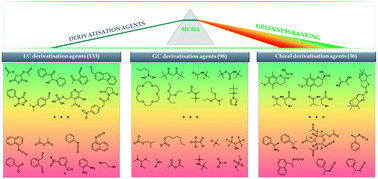A derivatisation agent selection guide
DOI: 10.1039/C7GC03108D, Paper
 Open Access
Open Access This article is licensed under a Creative Commons Attribution-NonCommercial 3.0 Unported Licence.
This article is licensed under a Creative Commons Attribution-NonCommercial 3.0 Unported Licence.The study reported herein is aimed at the greenness assessment of 267 derivatisation agents that are frequently applied in analytical chemistry and related disciplines.
A derivatisation agent selection guide
Abstract
The study reported herein is aimed at the greenness assessment of 267 derivatisation agents that are frequently applied in analytical chemistry and related disciplines. Multicriteria decision analysis allowed obtaining three rankings of derivatisation agents applied in liquid chromatography, gas chromatography and chiral analysis. The criteria of assessment included the safety information obtained from material safety data sheets and physicochemical and environmental parameters predicted with relevant models. As for some of the agents predicted data were not available, these agents were assessed with a smaller number of criteria, within the ranking of low confidence. The results of the study will help to apply greener derivatisation agents, wherever the green chemistry principle of avoiding derivatisation cannot be fulfilled.
The present study provides an assessment, in terms of greenness, of 267 LC, GC and chiral derivatisation agents typically used in analytical chemistry and related fields. The preference rankings were performed for each group of derivatisation agents by means of MCDA according to the best relevant criteria that are available. In all three cases fine rankings were obtained for high and low confidence assumptions. For more informative assessment, it would be beneficial to include toxicological endpoints and more information about environmental persistence among assessment criteria. Incorporating valuable greenness indicators of synthesis processes such as carbon footprint or energy needs during production of each chemical as assessment criteria would be worthwhile. Unfortunately, these values are not easily available in the literature for a satisfactory number of derivatisation agents. Furthermore, recovery of derivatisation agents is another important issue that influences the greenness of derivatisation reactions, so its inclusion as assessment criterion would also be desirable. However, it is dependent on reaction specific conditions – not only the kind of derivatisation agent matters, but also analytes to be determined and solvents employed. The greenness of derivatisation agents is very rarely considered during analytical method development. The main criteria for selection of derivatisation agents are their rapidity and efficiency, but greenness should be also considered. This study allows selecting less problematic derivatisation agents for analytical method development while some clues can also be deduced for other than analytical applications.


Gdańsk University of Technology


Jacek Namieśnik
//////////////

















